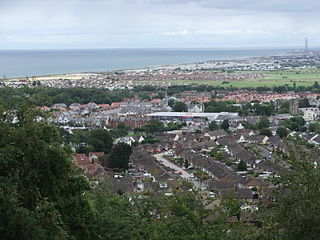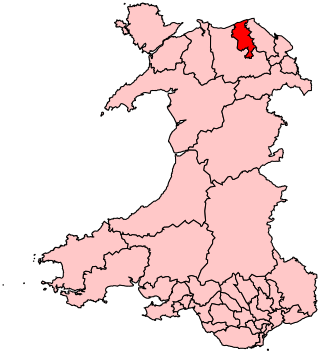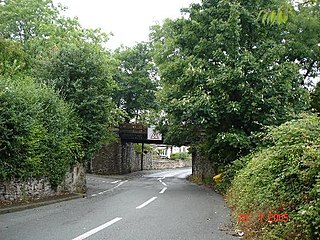
Denbighshire is a county in the north-east of Wales. It borders the Irish Sea to the north, Flintshire to the east, Wrexham to the southeast, Powys to the south, and Gwynedd and Conwy to the west. Rhyl is the largest town, and Ruthin is the administrative centre. Its borders differ from the historic county of the same name.

Flintshire is a county in the north-east of Wales. It has a maritime border with Merseyside along the Dee Estuary to the north, and land borders with Cheshire to the east, Wrexham County Borough to the south, and Denbighshire to the west. Connah's Quay is the largest town, while Flintshire County Council is based in Mold.

Rhyl is a seaside town and community within the historic boundaries of Denbighshire in Wales. The town lies on the coast of North East Wales, at the mouth of the River Clwyd.

Prestatyn is a seaside town and community in Denbighshire, Wales. Historically a part of Flintshire, it is located on the Irish Sea coast, to the east of Rhyl. Prestatyn has a population of 19,085.

Rhuddlan is a town, community, and electoral ward in the county of Denbighshire, Wales, in the historic county of Flintshire. Its associated urban zone is mainly on the right bank of the Clwyd; it is directly south of seafront town Rhyl. It gave its name to the Welsh district of Rhuddlan from 1974 to 1996. As of the 2001 census, the population was 4,296 decreasing to 3,709 in the 2011 census.

Abergele is a market town and community, situated on the north coast of Wales between the holiday resorts of Colwyn Bay and Rhyl, in Conwy County Borough and in the historic county of Denbighshire. Its northern suburb of Pensarn lies on the Irish Sea coast. Abergele and Pensarn railway station serves both resorts. Abergele is often overlooked due to the popularity of towns in nearby Rhyl, Prestatyn, Colwyn Bay, Llandudno and Conwy. Only 46.5% of the population was born in Wales as of the 2011 census.

The Vale of Clwyd is a constituency of the House of Commons of the UK Parliament created in 1997 and represented since 2019 by James Davies of the Conservative Party. As with all extant seats its electorate elect one Member of Parliament (MP) by the first past the post system at least every five years.

Prestatyn railway station on the North Wales Coast Line serves the town of Prestatyn in North Wales.
The Chester and Holyhead Railway was an early railway company conceived to improve transmission of Government dispatches between London and Ireland, as well as ordinary railway objectives. Its construction was hugely expensive, chiefly due to the cost of building the Britannia Tubular Bridge over the Menai Strait. The company had relied on Government support in facilitating the ferry service, and this proved to be uncertain. The company opened its main line throughout in 1850. It relied on the co-operation of other railways to reach London, and in 1859 it was absorbed by the London and North Western Railway.

Meliden is a village between Prestatyn and Dyserth in Denbighshire, Wales. It grew up around the locality of lead mines and limestone quarries. The placename "Meliden" has variously been claimed to be derived from that of Bishop Melitus or St. Melyd ; its Welsh placename, "Alltmelyd", means "wooded hill of Melyd". The railway between Prestatyn and Dyserth, long since lifted and formerly with sidings in the village, is now a public walkway and nature trek. It has a 9-hole golf course, which is split in half by the former railway/nature walk. The local school, St. Melyd Primary, is a feeder school to the High School, Prestatyn.

The Vale of Clwyd Railway (VoCR) was a standard-gauge line, which connected the settlements of Rhyl, St Asaph and Denbigh in North Wales. It opened in 1858, at first without a connection to the main line at Rhyl, but this was provided in 1862. At Denbigh, a connection could be made on to the Mold and Denbigh Junction Railway. Although the area became popular with holidaymakers from the 1920s, the line never realised its potential; it closed to passengers in 1955 and completely in 1968.
The Clwydian Way is a waymarked long-distance footpath in north-east Wales, mostly running through Denbighshire.
The Dyserth branch line was a short standard-gauge mineral railway between the northern end of the Clwydian Range at Dyserth and the North Wales Coast Line at Prestatyn. The line was constructed by the London and North Western Railway in 1869; it was built to carry quarried stone and coal. The rise of tourism led to the introduction of a passenger service in 1905. There were stations at Dyserth and Meliden, and basic halts were built at other stopping places. Competition from road transport led to the passenger service being withdrawn in 1930. With the eventual demise of all the mineral industries around Dyserth the entire line was closed in September 1973.

Meliden railway station served the mining village of Meliden, Flintshire, Wales, on the Dyserth branch line. It was used as a way of shipping minerals from the nearby quarries at Dyserth to Prestatyn. The branch line to Dyserth was opened by the LNWR in 1869, initially for mineral traffic only. A passenger service was instituted in 1905 but lasted only until 1930, when it was withdrawn by the LMS. The line remained open to serve a quarry at Dyserth until complete closure in 1973. Since closure the Prestatyn to Dyserth railway has become a nature walk. All that remains is the loading gauge and goods shed.

Woodland Park was an unstaffed halt on the Dyserth branch line in North Wales.

Dyserth railway station served the village of Dyserth, Flintshire, Wales. It was the southern terminus of the 2 miles 70 chains (4.6 km) Dyserth branch, most of which is now a public footpath. At its peak Dyserth had passengers in the thousands. In 1930 the line and station closed for passengers in the face of road competition. At one point fourteen trains a day had shuttled along the line. Although the station has long been demolished, a crane from the station has been installed at the end of the walk as a feature of historical interest, as have two pieces of track at Chapel Street.

St. Melyd Golf Links railway station was a stop on Dyserth branch line. Passengers would have to access from the Gwaenysgor facing side of the golf course. All that remains here is a post that has long overgrown with foliage. This post was probably used to bear the station name.
The Clwyd Football League was a football league formed in 1974 as an amalgamation of the Dyserth League and the Halkyn Mountain League. The top division was at different periods at the second, third and fourth levels of the Welsh football league system in North Wales. The league ran until 2011 when a split led to the formation of the Clwyd East Football League comprising Flintshire teams under the North East Wales Football Association and the Vale of Clwyd and Conwy Football League, made up of Denbighshire, Conwy county and Vale of Conwy sides, under the North Wales Coast Football Association.

















